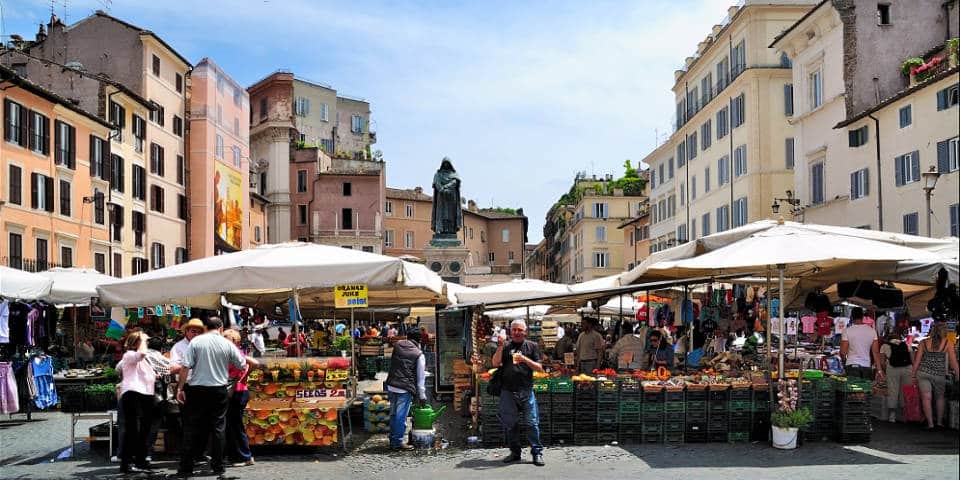

24785 views

| Tip | Come in the morning (around 7 AM to 1 PM) for the bustling market, and from 6–7 PM for an aperitivo, when the square comes alive with evening crowds. |
|---|---|
| Closest bus stops |
|
| Closest subway stations |
|
| Address | Campo de' Fiori, Roma |
The Campo de’ Fiori is one of the main squares of the Eternal City. It is renowned for its vibrant flower, fruit, and vegetable market during the daytime and its bustling restaurants and shisha bars at night.
Contents
ToggleCampo de’ Fiori was originally a meadow—its name literally means “Field of Flowers.” In 1456, Pope Callistus III ordered the district’s reorganization and paving, transforming what was once an untamed field into a lively urban space. During this redevelopment, many luxurious palaces were constructed, including Palazzo Orsini, which was partially built over the ruins of the ancient Theater of Pompey. Over time, the area evolved into a favored meeting place for ambassadors, cardinals, and other influential figures.
By the 16th century, the piazza hosted a horse market twice a week, drawing merchants and onlookers from across Rome. Campo de’ Fiori measures roughly 90 meters in length and 50 meters in width (about 295 by 164 feet), making it an important commercial hub. Numerous inns, artisan workshops, and eventually modern B&Bs sprang up around the square, contributing to its lasting reputation as one of the city’s most famous and dynamic locales.
Consequently, the market of horses appeared twice a week on the square.
Public executions also took place here, a grim aspect of the piazza’s past that is commemorated by its most notable monument—dedicated to Giordano Bruno.
Giordano Bruno, an Italian philosopher and Dominican friar, was condemned for heresy and burned at the stake in Campo de’ Fiori on February 17, 1600. He challenged the geocentric worldview by arguing that Earth orbits the sun—ideas deemed radical at the time.
In 1889, a statue honoring Bruno was erected at the center of the piazza. Sculpted by Ettore Ferrari, it stands nearly 4 meters (13 feet) tall atop a pedestal, with the hooded figure gazing defiantly toward the Vatican. This orientation symbolizes a posthumous challenge to the authorities that once condemned him. The monument has since become a symbol of free thought and intellectual courage, attracting admirers and curious visitors from around the world.
The Italian philosopher and Dominican monk was burned because he claimed that the Earth spins around the sun, and not vice versa, as people believed before. Bruno was accused of heresy and burned alive in Campo de’ Fiori on February 17, 1600. The monument was built in his honor in 1889.
The pedestal bears a plaque with the following text in Italian, featuring Roman numerals to mark the date:
IX GIUGNO MDCCCLXXXIX
A BRUNO
IL SECOLO DA LVI DIVINATO
QVI
DOVE IL ROGO ARSE
Translated into English, it reads:
June 9, 1889
To Bruno
The century that he foretold
Here
Where the pyre burned
“IX GIUGNO” stands for the 9th of June, while “MDCCCLXXXIX” translates to 1889 in Roman numerals. This inscription commemorates the statue’s unveiling date and pays homage to Bruno’s forward-looking ideas (“the century that he foretold”). It also marks the exact spot in Campo de’ Fiori where he was executed, forever linking his martyrdom to the cause of intellectual freedom and the pursuit of scientific truth.
In 1943, the Italian comedy film “Campo dei Fiori” (known in English as The Peddler and the Lady) was released, directed by Mario Bonnard.
Much of the movie is set in and around the square, depicting a romance between a greengrocer and a fishmonger. This lighthearted storyline contrasts with the piazza’s darker past and highlights its enduring place in Rome’s cultural imagination.
Today, Campo de’ Fiori hosts a daily market where visitors can browse the freshest fruits, vegetables, and flowers.
Vendors also sell spices, oils, and other local products that capture the flavors of Roman cuisine. The market typically operates in the morning and wraps up by early afternoon.
Today, you can find a daily market on the square and enjoy the freshest fruits and vegetables. Moreover, there are many different flowers that you can buy along the piazza.
At sunset, Campo de’ Fiori transforms into a renowned nightlife destination. Locals and tourists gather for aperitivo, dine at nearby restaurants, or relax in one of the shisha lounges.
The piazza and its surrounding streets are particularly popular among younger crowds, who fill the bars and cafes until late at night. Many famous gelaterias are also located in the vicinity, offering a sweet end to any evening.
Whether you visit by day for the bustling market or by night for the vibrant social scene, Campo de’ Fiori remains an essential stop for anyone looking to experience Rome’s cultural and historical richness.
Author: Artur Jakucewicz
This website uses cookies. For more info read the cookies policy
Rome.us © 2025. Created with love by Roman experts and guides.